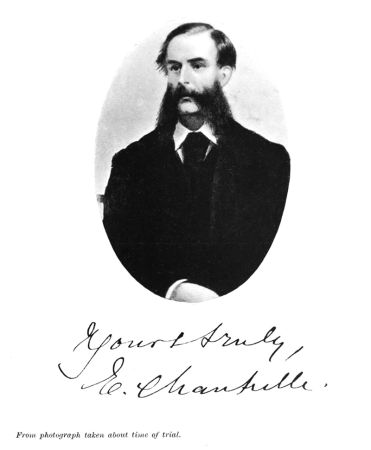Eugène Marie Chantrelle

Henry Littlejohn Collection.
Eugène Marie Chantrelle (1834-1878) was a French teacher who lived in Edinburgh and taught at the private Newington Academy. He began a relationship with a pupil, Elizabeth Dyer (born 1851, 15 years old at the time). They married when she was age 16, moved in together at 81a George Street, and Elizabeth gave birth to their first child 2 months after they were married.
Eugène Marie Chantrelle murdered his wife on 2 january 1878 and was convicted for his crimes and hanged at Calton Prison in Edinburgh, Scotland. The trial is claimed to have inspired Robert Louis Stevenson to write the story Strange Case of Dr Jekyll and Mr Hyde (1886). Stevenson met Eugène Chantrelle at the home of Victor Richon (Stevenson's old French master).
Eugène Marie Chantrelle and Arthur Conan Doyle
During the Autumn 1866, Arthur Conan Doyle (aged 7) attended the Newington Academy, 8 Arniston Place, Edinburgh where Eugène Marie Chantrelle taught him French.
It is possible that Conan Doyle met Elizabeth Dyer as they were attending the Academy the same year, though they weren't the same age.
Dr. Henry D. Littlejohn, who was the city's first medical officer, was not satisfied with the circumstances of Mrs. Chantrelle's death, and he had an autopsy performed by Dr. Douglas Maclagan, then Professor of Medical Jurisprudence in the University of Edinburgh. Littlejohn was a very good friend and colleague of Dr Joseph Bell, professor of Arthur Conan Doyle at the University of Edinburgh. But Bell is not mentioned in this case. However, an unverified anecdote is known: Chantrelle turning to Dr. Littlejohn who had come to witness the hanging, Chantrelle said to him: « Give my compliments to Joe Bell. He did a good job in bringing me to the scaffold. » So it is very likely that Littlejohn and Bell discussed the case or even worked on it together.
Photos
-
Eugène Marie Chantrelle (ca. 1867)
-
Eugène Marie Chantrelle (ca. 1878)
-
Elizabeth (Dyer) Chantrelle (ca. 1867)
Trial
- Download the full trial report here (Canada Law Book Co., 1906).



